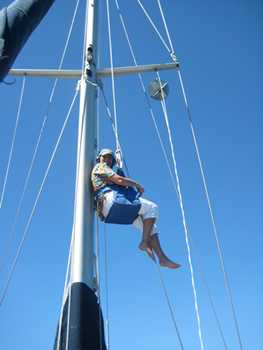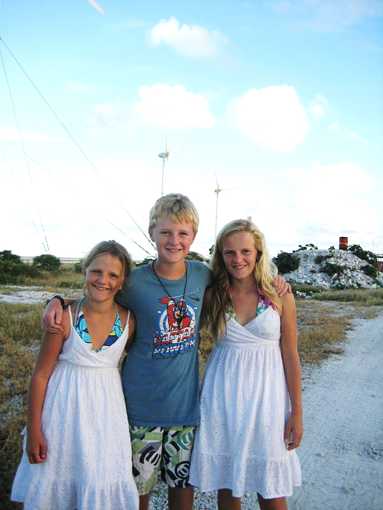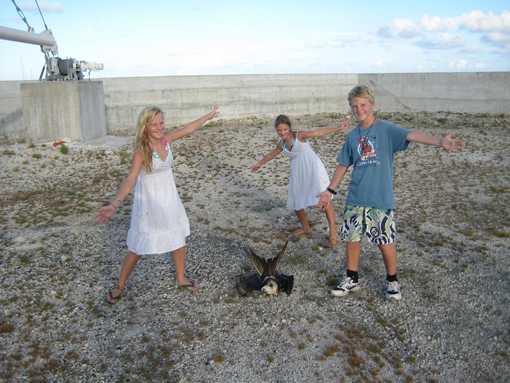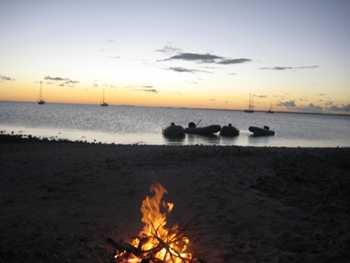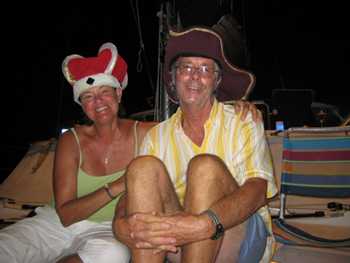Makemo to Fakarava in the Tuamotus

Peregrina's Journey
Peter and Margie Benziger
Tue 11 Jan 2011 00:26
Position Report –– 16:03.481S 145:37.339W
When I worked in Travel PR, my boss used to say that her
favorite place in the world was the last place she visited. That was usually a very diplomatic way to
keep everybody happy and a very good answer when pitching prospective
clients. But, you know, it seems to
apply very well to our adventure on Peregrina because every country, island, or
archipelago we visit becomes my favorite place in the world and that was
certainly no exception with the Tuamotus.
First of all, where ARE the Tuamotus? Believe me, I had never heard of them
either! We’ve been heading west,
southwest from Panama across vast stretches of the Pacific and every once in a
while we would run into an island chain like the Galapagos or the Marquesas or
an archipelago such as the Tuamotus.
(Correction! Peter just informed
me that it was not exactly an ACCIDENT that we arrived in the Galapagos,
Marquesas or Tuamotus and that I should give him some credit for his excellent
navigational skills rather than implying that we were just running around the
South Pacific randomly bumping into islands willy nilly!) Opps!!! A bit touchy, isn’t he?
Anyway, as we headed to French Polynesia (where we’ll visit
the more well-known destinations such as Tahiti, Bora Bora, and Moorea) we were
lucky enough to call upon these smaller islands and atolls that don’t
necessarily appear in travel brochures.
The Tuamotus are 69 low-lying atolls running approximately
700 miles along a line from the northwest to southeast as one approaches Tahiti
from the Marquesas. Early European
sailors named them the “Dangerous Archipelago” because of their tricky currents
and the fact that they cannot be seen until you are almost on top of them and
that is absolutely true.
The two atolls that we visited in the Tuamotus were Makemo
and Fakarava. Both were large,
rectangular shaped atolls (basically volcanic crater rims sticking out just
above and below the surface of the water) encompassing a beautiful but,
sometimes, treacherous lagoon. There are
69 atolls altogether in the Tuamotus – some you can anchor outside of and
dinghy into, some you can enter via passes or channels, some are entirely
enclosed. The two atolls we chose to
visit allowed us entry from one end and an exit out the other so we were able
to traverse the inside of the lagoon between anchorages. However, getting in and out through the
passes can be very difficult with the huge currents and not a lot of space to
maneuver. (Some of these passes are only
50-75 feet wide!) Once inside, you’re not home free either as the threat of
underwater or barely exposed rock formations made the journey very
nerve-wracking. Peter had to hoist me up
the mast on a bosun’s chair and I used our walkie-talkies to let him know about
all the danger zones so he could zig zag his way through. It was scary but, at the same time, pretty
cool from my perspective.
BTW, We LOVE our walkie-talkies! And everyone on the BWR wants to get a pair
now that they’ve seen us with ours! At
first, I thought, “There’s NO WAY you’re going to catch me wearing this dorky
headset and microphone.” The guy who was
trying to sell them to us called them “marriage savers” and he said we’d
understand why the first time we used them.
Well, he was right because they are mainly used for anchoring and when
someone is up the mast and you can’t hear very well due to distance and high
winds. If you have ever seen a couple
trying to anchor a boat in a storm with the woman on the bow and the man at the
helm and they are both SCREAMING at each other and trying all sorts of weird
hand signals (including one that includes use of the third digit) you can see
how these headsets would make the job a whole lot easier. As to navigating through a minefield of
underwater coral rock formations, you just can’t imagine how much better it is
to transmit information in a cool, calm manner.
I’m thinking about writing the company with a testimonial from
Peregrina. Maybe they will let us test
their new models for free?
Anyway, back to the Tuamotus….our first port of call was
Makemo, an elongated atoll about 40 miles long and 10 miles wide. We entered through the passage on the
northeast side of the atoll which has a huge outgoing current. We got in quite easily but the next day, one
of the other boats, “Fai Tiri”, got thrown around so much in the channel that
they had to go back out and try again a few hours later when the tide was
slack. At one point they had their engine at full throttle going forward and
they were actually going “backwards.”
Once inside, we
anchored in the harbor right outside the main village of Pouheva. There are only 300 people living there but
they do have a church and several small stores and a couple of
“restaurants.” One was really just a
family home with a big outside patio where 12 of us had dinner the first
night. It was fabulous! The next night, we went to a restaurant
called 20/20 Karaoke where 16 of us had dinner and sang karaoke quite TERRIBLY
all night long! It was funny because
everyone was so surprised when the others didn’t know songs that were
considered “famous” in their estimation.
Peter was amazed that everyone didn’t know the Beachboys’ “California
Girls” for example. However, he did lead
the group in a spirited version of “YMCA” and I did my best to teach everyone
the “Macarena” while Jaime and Carmen from “Bionic” sang the words in their
native Spanish!
Surprisingly, Makemo had five gigantic white wind vanes to
generate power for the village, a gift from the French. One afternoon, we took the three children
from “Miss Tippy” (Charlotte "Charlie", 13, Freddie, 11 and Annie 9) on a walk
to see the wind vanes so their parents could have a break. We call them “The Tiplets” and they are the
nicest kids. We love having them visit
us. Since they are being home-schooled
for two years, Peter is always trying to figure out fun educational things to
do with them so the wind vanes were an afternoon excursion that we couldn’t
pass up! We walked all around them – no
guards or fences to get in our way – and he talked to the kids about how they
were constructed and how they worked to generate energy. However, the best part of the day as far as
the kids were concerned was when Freddie discovered a large severed wing of a
bird that had obviously flown right into one of the wind vanes. And then, about 200 feet away, the rest of
the body. Yuck!!! Somehow, Peter was able to turn this rather
gruesome incident into a “teaching moment” when he got them to start estimating
how fast those wind-vanes really spin in order to cut the poor old birdy in two! It does appear that they rotate very slowly
but that is an optical illusion and, in truth, the tips of the wind vane can
spin up to 100 miles per hour! He also
got in a little physics lesson as well - discussing how much further away the
wing landed from the body of the bird which gravity had pulled swiftly down to
the ground. It was an unusual approach
to learning that one certainly wouldn’t find in a normal lesson plan. I’m not sure if this was exactly what the
Tiplets’ parents imagined when they sent us off on our “field trip” but they
treated us to a lovely steak dinner on their boat that night and we had a
really great day.
We left Pouheva the next morning and headed to the northwest
end of the lagoon - me up the mast on the lookout with my “walkie talkies” and
baking in the noonday sun. It was a
little dicey as we left later than we should have and the afternoon sun was
right in my eyes but we arrived OK (see Peter’s email for more details) and
that night, we had dinner and a huge bonfire on the deserted beach with 11 of
us from five boats - Peregrina, Simanderal, Bionic, Fai Tiri and Spirit of
Nina. The next day, we exited through
the pass and sailed overnight to Fakarava.
Arriving in Fakarava before daylight, we had no trouble
getting through the pass at the southern end of the atoll as soon as the sun
came up. We anchored offshore and, that
evening, we had a great dinner in an over-the-water restaurant which was part
of a little dive shop/guesthouse in the village of Tetamanu. The village of Tetamanu is mostly ruins
now. It was a thriving community in the
late 1800/early 1900’s but is now virtually abandoned except for the diving
operation. The next day we snorkeled right off the beach there and, less than
100 feet from shore, we came to a wall which descended hundreds of feet
straight down and I have honestly never seen so many beautiful fish in my
life! Thousands of them in so many
brilliant colors it was incredible!!! We
were swimming with HUGE Emperor fish and dozens of blacktip sharks just a
couple feet away from us! It was
awesome!!!!
That night, we had an invitation from the owner of another guest
house about a mile down the atoll who said that he would be delighted to host
our BWR group and three other random boats in the anchorage for a “bring your
own” potluck dinner. His name was
Manihi Salmon, a native Tuamotan of Scottish descent. He looked like an image out of a travel
brochure - a Polynesian God with long salt and pepper hair, no shirt and a pink
and blue sarong! I’m not kidding! I was IN LOVE!!! He runs this incredible little resort with 8
darling bungalows and a huge, wonderful outdoor dining area with a narrow
passage of water running from the ocean to the lagoon right through the
middle! He has the water illuminated at
night and you can see all the fish and sharks swimming practically right under
your feet. It was so cool. Manihi generates his electricity through
solar panels and the water is collected off the roofs into cisterns. We had a
great time and met a lot of really nice people including 16 people aboard
“Infinity” the largest ferro-cement boat in the world…so they said. It’s a sort of eco-adventure charter boat
that you sign on to for a minimum of 3 months.
They had people from all over the world and it seemed pretty cool…
The next morning, we had planned to leave early for the main
village of Rotoava. However, three out of the four boats found our anchors had
gotten entangled in the coral heads below and it took us some time to unravel
the chains. Luckily, Hans and Jann, our
Swedish contingent from “Natibou” volunteered to jump in their dinghy with
masks and snorkels and they swam down each one of our anchor lines and directed
us back and forth and around the coral heads until we were all free. Just another example of how everyone on the
BWR works together to keep us safe and on to the next destination.
We then had a relatively easy sail over 38 miles to Rotoava
with only a few coral heads peeking through the surface and a couple hundred
buoys (the English pronounce them “boys”) marking pearl farming equipment to
avoid along the way. Rotoava was a
bustling little community of about 900 people with most everyone either fishing
or pearl farming for a living. Those that don’t work here in the French
Polynesian islands get generous subsidies from the French government so there’s
very little crime and people are, in general, a very happy lot. I made my contribution for the good of
society when I purchased a beautiful black pearl necklace, much to Peter’s
chagrin. LOL
Some of the other cruisers actually went out on tours to the
pearl farms and were able to dive for their own pearls as part of the package
price. The guide takes you to an area
where the pearls are gestating in the oysters approximately 15 feet below the
surface. They are suspended in nets down
under the water and you select a string of five oysters hung on each net, cut
it loose from the others and then bring it back to the boat. From there, the guide drives back to the farm
and you open your oyster to see what’s inside.
You select the best (or largest) pearl from your string of oysters to
keep. Out of 100 oysters, 30 will not
survive the shock of the grafting operation, another 30 will reject the grafted
nucleus and 5 of the last 40 (just 2%) will yield what is considered a
marketable pearl so the chances of finding a real “gem” are slim but Sue from
“Camomile” found a pearl that measured over 12 mm and was quite
spectacular. The guide estimated that it
was worth at least 10,000 francs which would be approximately $106 right there
at the farm. Imagine what the mark-up
would be by the time it reached Europe or the USA?
Leaving Rotoava behind, we exited the atoll the next day
with Peregrina leading a group of three other yachts out a fairly rough pass
and heading due west for Tahiti. This
would be a two night passage with anticipation building as we realized that,
for the first time in several weeks, we would all be together again in one place
– Papeete , here we come!!!
